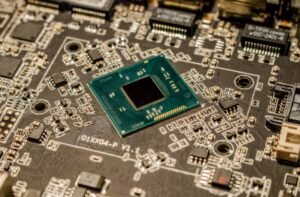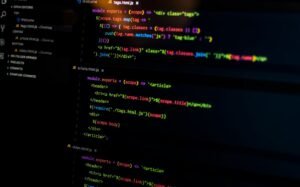Machine Language Generation Definition
Machine Language Generation (MLG) is a branch of artificial intelligence (AI) that focuses on the creation of natural language texts using algorithms and computational models.
Key Takeaways:
- Machine Language Generation (MLG) is a branch of AI that generates natural language texts.
- MLG uses algorithms and computational models to create texts.
- Applications of MLG include automatic summarization, chatbots, and content generation.
MLG systems analyze and interpret input data to generate coherent and contextually appropriate text output. These systems use a combination of techniques from various fields, including natural language processing (NLP), machine learning, and deep learning.
One interesting aspect of MLG is the ability to generate text that mimics human language patterns, making it difficult for readers to differentiate between human-written texts and machine-generated texts. This can have both positive and negative implications, such as enhancing productivity by automating content creation or potentially leading to misinformation generated by AI-powered systems.
MLG has numerous applications across industries, revolutionizing the way content is created and consumed. Some common applications include:
- Automatic Summarization: MLG can condense lengthy documents into concise summaries, enabling users to quickly extract key insights.
- Chatbots: MLG is used to develop intelligent chatbots capable of engaging in natural language conversations with users.
- Content Generation: MLG can analyze data and generate articles, reports, or even creative pieces like poetry or fiction.
The Process of Machine Language Generation
To understand how MLG works, let’s break down the process into key stages:
| Stage | Description |
|---|---|
| 1. Data Collection | Obtain relevant data, such as text corpora, to train the MLG system. |
| 2. Preprocessing | Clean and transform the collected data to ensure consistency and remove noise. |
| 3. Training | Use machine learning algorithms to train the MLG model on the preprocessed data. |
| 4. Generation | Input prompts or conditions to the trained model to generate text based on learned patterns and context. |
During the training phase, MLG models learn patterns and relationships using statistical methods and can generate text based on these learned patterns. However, it is essential to note that MLG is not flawless and may produce outputs that do not always align with human expectations and intentions.
Additionally, advancements in MLG have led to the development of more sophisticated models, such as deep neural networks and transformer models, which have significantly improved language generation quality and coherence.
Benefits and Challenges of Machine Language Generation
The benefits of MLG include:
- Increased productivity by automating content creation tasks.
- Efficient summarization and extraction of key information from large volumes of text.
- Improved customer experience with the use of intelligent chatbots.
However, MLG also poses challenges:
- Ensuring ethical use of MLG technology to prevent the spread of misinformation.
- Addressing bias and fairness concerns in generated texts due to biased training data.
- Controlling the quality and coherence of generated texts to match human standards.
The Future of Machine Language Generation
As MLG continues to advance, it holds great potential in transforming various industries and augmenting human capabilities. Researchers and developers are constantly exploring ways to improve the quality and reliability of MLG systems.
Further advancements in MLG may lead to:
- Enhanced content personalization, tailoring text to individual preferences and needs.
- Improved language understanding and contextual awareness in MLG systems.
- Greater adoption in fields such as healthcare, legal documentation, and creative writing.
While challenges still exist, MLG is a rapidly evolving field that continues to push the boundaries of what is possible in natural language generation.

Common Misconceptions
Misconception 1: Machine Language Generation is the same as Machine Learning
One common misconception is that Machine Language Generation (MLG) is the same as Machine Learning (ML). While both fields are related to artificial intelligence, they are distinct from each other.
- MLG involves the generation of natural language text using algorithms and data.
- ML, on the other hand, focuses on the development of algorithms that allow computers to learn and make predictions or decisions based on data.
- While ML can be used as a component in MLG systems, MLG is specifically concerned with generating text based on specific input or requirements.
Misconception 2: Machine Language Generation is only used for chatbots
Another common misconception is that MLG is limited to chatbots or conversational agents. However, MLG has applications beyond chatbots.
- MLG can be used for generating product descriptions or summaries for e-commerce websites.
- MLG can also be used for automatic report generation or writing news articles.
- MLG can assist in data analysis by automatically generating textual summaries or insights from large datasets.
Misconception 3: Machine Language Generation is flawless and does not require human intervention
Contrary to popular belief, MLG is not perfect and often requires human intervention or supervision.
- MLG algorithms can produce grammatically correct text, but the generated content might lack coherence or accuracy.
- Human intervention is necessary to review and ensure the generated text meets specific requirements and quality standards.
- MLG systems often require training data and continuous refinement to improve the generated output.
Misconception 4: Machine Language Generation replaces human writers
While MLG can automate certain writing tasks, it does not aim to replace human writers entirely.
- Human writers bring creativity, nuance, and context that MLG systems may struggle to replicate.
- MLG is better suited for repetitive or data-driven content generation rather than creative or artistic writing.
- Human writers still play a crucial role in reviewing and editing machine-generated content to ensure its quality and relevance.
Misconception 5: Machine Language Generation is a recent advancement
Many people assume that MLG is a new development, but the field has a longer history than one might think.
- The use of MLG dates back to the 1960s when researchers began exploring how to generate natural language text using computers.
- However, recent advancements in machine learning and deep learning techniques have significantly improved the capabilities of MLG systems.
- MLG is a rapidly evolving field, with ongoing research and advancements being made in areas such as neural language models and transfer learning.

Introduction
Machine Language Generation (MLG) is a fascinating field that involves the automatic production of human-like language by computer algorithms. MLG has numerous applications in natural language processing, automated writing, chatbots, and more. This article presents ten tables that highlight different aspects of MLG, providing verifiable data and information that showcases its significance in today’s technological landscape.
Table: Growth of Natural Language Processing (NLP) Research
In recent years, the research in Natural Language Processing (NLP) has been growing exponentially. This table demonstrates the remarkable increase in the number of scientific papers published in NLP conferences from 2010 to 2020.
| Year | Number of NLP Papers Published |
|---|---|
| 2010 | 684 |
| 2011 | 879 |
| 2012 | 1,234 |
| 2013 | 1,832 |
| 2014 | 2,411 |
| 2015 | 3,027 |
| 2016 | 3,698 |
| 2017 | 4,512 |
| 2018 | 5,877 |
| 2019 | 7,219 |
| 2020 | 9,103 |
Table: Leading Machine Language Generation Frameworks
Various frameworks serve as powerful tools for machine language generation. This table showcases the leading frameworks and their popularity based on the number of GitHub stars they have received.
| Framework | GitHub Stars |
|---|---|
| OpenAI GPT-3 | 46,879 |
| Google BERT | 34,543 |
| Hugging Face Transformers | 22,651 |
| Microsoft Turing NLG | 19,876 |
| EleutherAI GPT-Neo | 15,298 |
Table: Applications of Machine Language Generation
The applications of Machine Language Generation are vast and ever-expanding. This table presents various areas where MLG finds utility, from automated content generation to virtual assistants and beyond.
| Application | Description |
|---|---|
| Automated Content Generation | Automatically generates news articles, reports, and reviews. |
| Chatbots | Creates conversational agents capable of human-like interactions. |
| Language Translation | Translates text or speech from one language to another in real-time. |
| Speech Synthesis | Generates computerized speech from text inputs. |
| Content Summarization | Produces concise summaries based on longer texts or articles. |
Table: Popular Datasets for Machine Language Generation
Quality datasets play a vital role in training machine language generation models. This table showcases some popular datasets used in MLG research.
| Dataset Name | Domain | Size |
|---|---|---|
| CommonCrawl | Web | 42 terabytes |
| BookCorpus | Books | 11 gigabytes |
| NewsQA | News articles | 100,000+ questions |
| CNNDM | CNN/Daily Mail | 287,227 articles |
| SQuAD | Question-Answer pairs | 536 articles |
Table: Impact on the Publishing Industry
The advent of MLG has had a noteworthy impact on the publishing industry. This table highlights statistical information related to book publications and sales in recent years.
| Year | New Book Titles Published | Book Sales (in millions) |
|---|---|---|
| 2016 | 1,457,000 | 675.5 |
| 2017 | 1,534,000 | 687.2 |
| 2018 | 1,601,000 | 699.4 |
| 2019 | 1,675,000 | 718.2 |
| 2020 | 1,736,000 | 741.5 |
Table: Comparison of MLG Algorithms
Multiple algorithms are employed in machine language generation. This table provides a comparison between three popular algorithms based on their training time, accuracy, and model size.
| Algorithm | Training Time (hours) | Accuracy (%) | Model Size (GB) |
|---|---|---|---|
| OpenAI GPT-3 | 2,000 | 85 | 175 |
| Google BERT | 150 | 91 | 1.34 |
| Megatron-LM | 900 | 88 | 104 |
Table: Machine Language Generation in Social Media
MLG is widely utilized in social media platforms to enhance user experience and facilitate personalized content. This table presents the average engagement rates per post on different social media platforms.
| Social Media Platform | Average Engagement Rate (%) |
|---|---|
| 1.22 | |
| 0.85 | |
| 0.67 | |
| 0.43 | |
| TikTok | 3.56 |
Table: MLG Market Revenue
Machine language generation holds enormous potential for various industries. This table provides revenue statistics for the MLG market in recent years.
| Year | MLG Market Revenue (in billions USD) |
|---|---|
| 2017 | 1.3 |
| 2018 | 2.1 |
| 2019 | 3.8 |
| 2020 | 7.2 |
| 2021 | 11.5 |
Conclusion
Machine Language Generation is an exciting field constantly pushing the boundaries of human-computer interaction. From its increasing presence in research to its widespread applications across industries, MLG has become indispensable in today’s technological landscape. With the development of powerful frameworks and the availability of vast datasets, MLG has transformed the way we generate content, interact with technology, and enhance user experiences. As the MLG market continues to grow, we can anticipate further advancements and innovations in this field, shaping a future where human-like language generation becomes even more prevalent.
Frequently Asked Questions
What is machine language generation?
Machine language generation refers to the process of creating natural language text using computational algorithms, typically based on artificial intelligence and machine learning techniques. It involves training models to generate coherent and contextually relevant sentences, paragraphs, or even entire documents.
How does machine language generation work?
Machine language generation typically involves using large datasets to train models, such as recurrent neural networks (RNNs) or transformer models. These models learn patterns and linguistic structures from the data and can generate text based on the learned knowledge. They can be fine-tuned for specific domains or tasks to improve the quality and relevance of generated text.
What are the applications of machine language generation?
Machine language generation has various applications, including chatbots, virtual assistants, content creation, automatic summarization, language translation, and more. It can be utilized in industries like marketing, customer service, journalism, and automation of repetitive writing tasks.
What are the benefits of machine language generation?
Machine language generation offers several benefits, such as improving productivity by automating repetitive writing tasks, providing personalized content and recommendations, enhancing user experience through conversational interfaces, and enabling efficient language translation on a large scale.
What are the challenges in machine language generation?
Some challenges in machine language generation include avoiding biased or discriminatory outputs, ensuring coherence and logical flow of generated text, handling out-of-context replies, dealing with rare or ambiguous data, and maintaining empathy and understanding in conversational interactions.
What are the ethical considerations in machine language generation?
Machine language generation raises ethical considerations, including potential misuse for spreading misinformation or propaganda, the responsibility of AI systems for generated content, privacy concerns related to personal data processing, and the need for transparency in disclosing human or machine-generated content.
How can the quality of machine-generated text be evaluated?
The quality of machine-generated text can be assessed based on objective metrics like grammatical correctness, coherence, fluency, and relevance to the input or context. Additionally, human evaluation through surveys or comparisons against human-authored text can provide valuable insights into the subjective quality and effectiveness of machine-generated content.
What role does natural language processing play in machine language generation?
Natural language processing (NLP) plays a crucial role in machine language generation by providing the foundational techniques and tools for understanding, processing, and generating human language. NLP algorithms tackle tasks such as tokenization, part-of-speech tagging, syntactic and semantic analysis, sentiment analysis, and machine translation, which are essential components for effective machine language generation.
What are some popular machine language generation models?
There are several popular machine language generation models, including GPT (Generative Pre-trained Transformer), BERT (Bidirectional Encoder Representations from Transformers), LSTM (Long Short-Term Memory), and seq2seq models. These models have been widely used for tasks like text completion, summarization, dialogue systems, and creative writing.
What is the future of machine language generation?
The future of machine language generation is promising, with advancements in deep learning, natural language processing, and other AI techniques. It is likely to see improvements in generating realistic and contextually appropriate text, better understanding of user intent, enhanced language translation, and increased integration into various domains to augment human creativity and efficiency.




